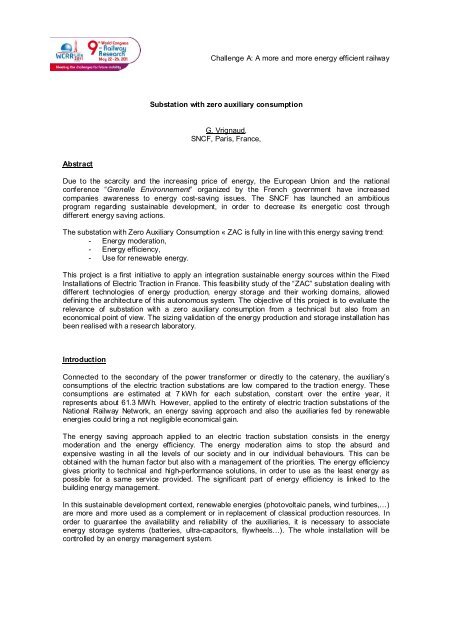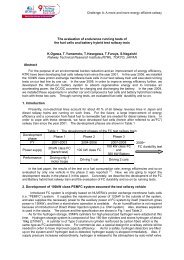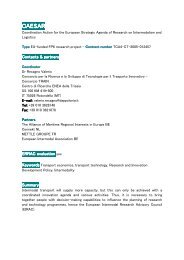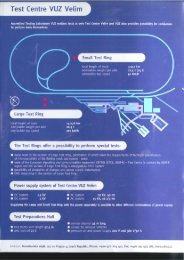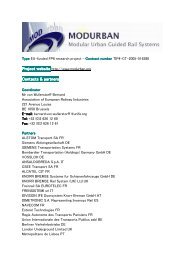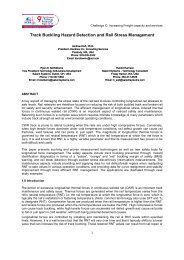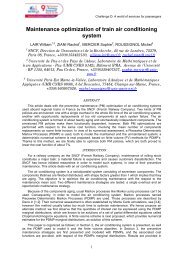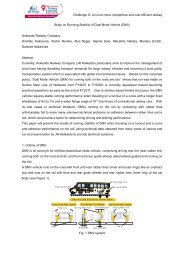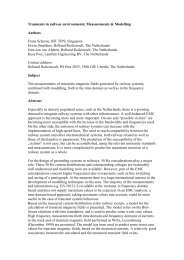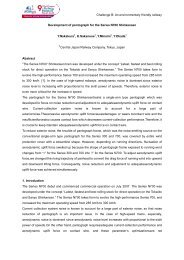Challenge A: A more and more energy efficient railway Substation ...
Challenge A: A more and more energy efficient railway Substation ...
Challenge A: A more and more energy efficient railway Substation ...
Create successful ePaper yourself
Turn your PDF publications into a flip-book with our unique Google optimized e-Paper software.
<strong>Challenge</strong> A: A <strong>more</strong> <strong>and</strong> <strong>more</strong> <strong>energy</strong> <strong>efficient</strong> <strong>railway</strong><br />
<strong>Substation</strong> with zero auxiliary consumption<br />
G. Vrignaud,<br />
SNCF, Paris, France,<br />
Abstract<br />
Due to the scarcity <strong>and</strong> the increasing price of <strong>energy</strong>, the European Union <strong>and</strong> the national<br />
conference “Grenelle Environnement” organized by the French government have increased<br />
companies awareness to <strong>energy</strong> cost-saving issues. The SNCF has launched an ambitious<br />
program regarding sustainable development, in order to decrease its energetic cost through<br />
different <strong>energy</strong> saving actions.<br />
The substation with Zero Auxiliary Consumption « ZAC is fully in line with this <strong>energy</strong> saving trend:<br />
- Energy moderation,<br />
- Energy efficiency,<br />
- Use for renewable <strong>energy</strong>.<br />
This project is a first initiative to apply an integration sustainable <strong>energy</strong> sources within the Fixed<br />
Installations of Electric Traction in France. This feasibility study of the “ZAC” substation dealing with<br />
different technologies of <strong>energy</strong> production, <strong>energy</strong> storage <strong>and</strong> their working domains, allowed<br />
defining the architecture of this autonomous system. The objective of this project is to evaluate the<br />
relevance of substation with a zero auxiliary consumption from a technical but also from an<br />
economical point of view. The sizing validation of the <strong>energy</strong> production <strong>and</strong> storage installation has<br />
been realised with a research laboratory.<br />
Introduction<br />
Connected to the secondary of the power transformer or directly to the catenary, the auxiliary’s<br />
consumptions of the electric traction substations are low compared to the traction <strong>energy</strong>. These<br />
consumptions are estimated at 7 kWh for each substation, constant over the entire year, it<br />
represents about 61.3 MWh. However, applied to the entirety of electric traction substations of the<br />
National Railway Network, an <strong>energy</strong> saving approach <strong>and</strong> also the auxiliaries fed by renewable<br />
energies could bring a not negligible economical gain.<br />
The <strong>energy</strong> saving approach applied to an electric traction substation consists in the <strong>energy</strong><br />
moderation <strong>and</strong> the <strong>energy</strong> efficiency. The <strong>energy</strong> moderation aims to stop the absurd <strong>and</strong><br />
expensive wasting in all the levels of our society <strong>and</strong> in our individual behaviours. This can be<br />
obtained with the human factor but also with a management of the priorities. The <strong>energy</strong> efficiency<br />
gives priority to technical <strong>and</strong> high-performance solutions, in order to use as the least <strong>energy</strong> as<br />
possible for a same service provided. The significant part of <strong>energy</strong> efficiency is linked to the<br />
building <strong>energy</strong> management.<br />
In this sustainable development context, renewable energies (photovoltaic panels, wind turbines,…)<br />
are <strong>more</strong> <strong>and</strong> <strong>more</strong> used as a complement or in replacement of classical production resources. In<br />
order to guarantee the availability <strong>and</strong> reliability of the auxiliaries, it is necessary to associate<br />
<strong>energy</strong> storage systems (batteries, ultra-capacitors, flywheels…). The whole installation will be<br />
controlled by an <strong>energy</strong> management system.
<strong>Challenge</strong> A: A <strong>more</strong> <strong>and</strong> <strong>more</strong> <strong>energy</strong> <strong>efficient</strong> <strong>railway</strong><br />
The application of this <strong>energy</strong> saving approach to the auxiliaries of an electric traction substation<br />
will allow demonstrating the pertinence of such a system in <strong>railway</strong>. This feasibility study of the<br />
“ZAC” substation dealing with different technologies of <strong>energy</strong> production, <strong>energy</strong> storage <strong>and</strong> their<br />
working domains, will allow to define the architecture of this autonomous system. The objective of<br />
this project is to evaluate the relevance of substation with a zero auxiliary consumption from a<br />
technical but also from an economical point of view. The sizing validation of the <strong>energy</strong> production<br />
<strong>and</strong> storage installation will be realised with a research laboratory. This tries will be completed by<br />
the installation of a prototype on a line post in the draft line electrification Bourges – Saincaize.<br />
Figure 1: Caricatural représentation<br />
Auxiliaries services (identification <strong>and</strong> load cycle)<br />
A transformer of auxiliaries in a substation ensures the conversion <strong>and</strong> distribution network usual<br />
voltage with 50Hz frequency. The distribution of auxiliaries is integrated in two control panels: one<br />
alternative <strong>and</strong> another continuous.<br />
Alternative auxiliary services must ensure the:<br />
- Power supply of battery chargers, heating of cabinets, control panel of outdoor<br />
equipment,<br />
- Power supply of indoor <strong>and</strong> outdoor lightings of buildings, heating of premises,<br />
protection against fire, portable lightings, radio controlled clock, signalling, telecom <strong>and</strong><br />
metering equipment,<br />
Continuous ancillary services must ensure the:<br />
- Power supply of auxiliary circuits of 25kV equipment such as : motor comm<strong>and</strong>s<br />
breakers <strong>and</strong> disconnections, protections, electronic equipment,<br />
- Power supply of driving equipment <strong>and</strong> control of the facilities such as : power<br />
converters, remote control, PLC, fire detection, intrusion, radio controlled clock,<br />
The charge cycle linked with the consumption of ancillary services is defined under two conditions:<br />
- St<strong>and</strong>ard permanent consumption evaluated at 7kW according to the equipment<br />
characteristics <strong>and</strong> approved by the feed back campaign of substations recently<br />
implemented,<br />
- Estimated binge according to the maintenance periods in force at SNCF
<strong>Challenge</strong> A: A <strong>more</strong> <strong>and</strong> <strong>more</strong> <strong>energy</strong> <strong>efficient</strong> <strong>railway</strong><br />
16<br />
14<br />
12<br />
Puissance en kW<br />
10<br />
8<br />
6<br />
4<br />
2<br />
0<br />
1 h<br />
3 h<br />
5 h<br />
7 h<br />
9 h<br />
11 h<br />
13 h<br />
15 h<br />
17 h<br />
19 h<br />
21 h<br />
23 h<br />
1 h<br />
3 h<br />
5 h<br />
7 h<br />
9 h<br />
11 h<br />
13 h<br />
15 h<br />
17 h<br />
19 h<br />
21 h<br />
23 h<br />
Heure<br />
Cycle de charge représentatif d'une intervention de maintenance préventive<br />
Cycle de charge représentatif d'une intervention de maintenance corrective<br />
Cycle de charge permanent annuel (hors intervention)<br />
Figure 2: Load cycle studied<br />
The <strong>energy</strong> saving approach<br />
Energy moderation is inseparable from the development of renewable <strong>energy</strong>. It is an essential<br />
step on the way to <strong>energy</strong> independence of the reducing consumption of fossil fuels. This approach<br />
perfectly illustrates the procedure to follow to approach an <strong>energy</strong> virtuous system <strong>and</strong> not just<br />
financial. It applies to several situations <strong>and</strong> fields, proposes to open various themes <strong>and</strong> thus allow<br />
thinking about the best solutions to be implemented by priority.<br />
Tendance = Tendency<br />
Sobriété = Economy<br />
Efficacité = Efficiency<br />
Renouvelables = Renewables<br />
Figure 3: The <strong>energy</strong> saving approach<br />
Beside human responsibilities <strong>and</strong> behaviour, the <strong>energy</strong> economy acts essentially on management<br />
of priorities. It allows identifying within a functional approach, the essential <strong>and</strong> priority holder<br />
consumers during the operation of the electric power substation. The respect of the st<strong>and</strong>ard<br />
“materiel <strong>and</strong> telecom system requirements for performance IEC 870-4”, is considered as priority<br />
management by supervision system.
<strong>Challenge</strong> A: A <strong>more</strong> <strong>and</strong> <strong>more</strong> <strong>energy</strong> <strong>efficient</strong> <strong>railway</strong><br />
Energetic efficiency focus on technical solutions for <strong>efficient</strong> use less <strong>energy</strong> possible for the same<br />
service rendered. The current approach linked to the general design of a substation, goes towards<br />
a st<strong>and</strong>ardization, which aim consists of apply <strong>and</strong> install equipment <strong>and</strong> render the systems<br />
uniform on the <strong>railway</strong> network. The need of <strong>energy</strong> efficiency is ideal for the evolution of<br />
st<strong>and</strong>ardization procedure through the approach of control of <strong>energy</strong>. Up to day, changing<br />
technologies specially <strong>energy</strong> management of building, (heat insulation, lightings, heating) <strong>and</strong> the<br />
control of electric devices, prove that the new developed systems in industry, take into<br />
consideration these notions <strong>and</strong> they likely to interfere in the changing of installed equipment.<br />
Two sources of <strong>energy</strong> improvement have been noticed:<br />
- la building <strong>energy</strong> management, by :<br />
• Better heat insulation of building due to the respect of thermal Rule RT2005 (a<br />
study shows <strong>energy</strong> gain is estimated for about 4000KWH/year).<br />
• Indoor lighting management by setting up of multiplier detector presence with builtin<br />
light meter <strong>and</strong> outdoor lighting by setting up of LED projectors (<strong>energy</strong> gain is<br />
estimated for about 60% comparing to actual lighting.<br />
• HVAC control in two approaches air heating <strong>and</strong> geothermal<br />
- Electrical switch st<strong>and</strong> by :<br />
• Innovation solution allowing to feed the electric comm<strong>and</strong><br />
independently by photovoltaic cell i.e. zero consumption<br />
• Full electrical relay<br />
Availability of sources of renewable <strong>energy</strong> production <strong>and</strong> storage associated<br />
The aim is to replace the fossil <strong>energy</strong> by renewable <strong>energy</strong>. Two solutions might be easily<br />
workable on an isolated site in a substation: Solar <strong>energy</strong> <strong>and</strong> wind power.<br />
Concerning storage device, RAGONE diagram has permitted to compare the energetic<br />
performances of each technology. RAGONE diagram is the device commonly admitted; on<br />
logarithmic scale, it places as specific power (in w/kg) according to the specific <strong>energy</strong> of storage<br />
device (in wh/kg). The outcome of the possible use of three workable solutions is complementary<br />
further to use in electrical substation, batteries, ultra capacitors <strong>and</strong> flywheel inertia.
<strong>Challenge</strong> A: A <strong>more</strong> <strong>and</strong> <strong>more</strong> <strong>energy</strong> <strong>efficient</strong> <strong>railway</strong><br />
Figure 4 : System architecture <strong>and</strong> storage of <strong>energy</strong> production with supervision<br />
Model conception<br />
The first design of electric substation with zero auxiliary consumption “CAN” carried out by the<br />
software HOMER ENERGY, shows that the solution generating sources of renewable <strong>energy</strong><br />
combined is the most advantageous. The proliferation of solar <strong>and</strong> wind <strong>energy</strong> deposits <strong>and</strong><br />
substantially reduces the capacity of storage devices with batteries. For their production, these two<br />
sources are balanced <strong>and</strong> complementary. In fact, the sources of production of photovoltaic <strong>energy</strong><br />
are <strong>more</strong> important during times estivalle while wind generation sources are <strong>more</strong> important during<br />
winter. Unlike photovoltaic systems or wind <strong>energy</strong> production, only this combination of two systems<br />
of production of <strong>energy</strong> consumption leads to a relatively homogeneous, which generates a low<br />
level of availability of <strong>energy</strong> as well as low in excess <strong>energy</strong>.<br />
The work done under the pre design validation of previous guides into three main parts:<br />
The first studies the development of a model in MATLAB/SIMULINK, in order to observe the system<br />
behaviour in terms of power out put fluctuations intrinsic to generators of renewable wind <strong>and</strong><br />
photovoltaic types as wells as based on different combinations of storage systems in place.<br />
The second part validates the previous results experimentally on a test bench locates in the school<br />
HEI in Lille.<br />
At last, the third part, occupies the validation of the first design of the system in order to assess the<br />
needs of production <strong>and</strong> storage of sub station further to the specific constraints of sunshine <strong>and</strong><br />
wind.
<strong>Challenge</strong> A: A <strong>more</strong> <strong>and</strong> <strong>more</strong> <strong>energy</strong> <strong>efficient</strong> <strong>railway</strong><br />
The simulation results show the interest of a combination of storage systems with batteries <strong>and</strong> ultra<br />
capacitors. In fact, the battery will provide or store the power fluctuations in order to obtain the<br />
output of the power converter P charge of 7Kw.<br />
Profiles of real power from renewable generators are very volatile. The battery will undergo very<br />
large changes in its terminals. Yet, it is not expected to produce as many rounds in such a short<br />
time. We must, therefore, put in place in the supervision of the filtering equation powers to smooth<br />
these variations in order not to reduce the lifetime of this storage system.<br />
Figure 5 : Model concept of MATLAB / SIMULINK system<br />
The figure here below shows the management of the slow component from the battery <strong>and</strong> the<br />
management of the fast component by ultra capacitors.<br />
Curve of power sent to<br />
the battery<br />
Curve of power sent to<br />
the ultra capacitor<br />
Figure 6 : Monitoring <strong>and</strong> filtering of all battery ultra capacitors
<strong>Challenge</strong> A: A <strong>more</strong> <strong>and</strong> <strong>more</strong> <strong>energy</strong> <strong>efficient</strong> <strong>railway</strong><br />
The many experiments conducted have proved the optimal design of a final source of combined<br />
photovoltaic <strong>and</strong> wind. The power of the annual consumption of 62.1MWh/year of auxiliary services<br />
of the electric traction substation needs to be implemented:<br />
• A solar power 23KW ( area 116sq.m. according to the technologies)<br />
• Wind power of 25kW at a high level of 20meters<br />
In spite of first design approach <strong>and</strong> validation of laboratory tests, many questions still remain about<br />
the implementation of <strong>energy</strong> storage devices. In fact, defining the time of the unavailability of<br />
<strong>energy</strong> production facility <strong>and</strong> the weather very r<strong>and</strong>om does not ensure the objective full autonomy<br />
of the installation by design optimized storage devices. But laboratory tests have provided certainly<br />
on the choice of the association of battery components <strong>and</strong> ultra capacitors but eh distribution of<br />
absorbed power between the two storage components to be installed is not validated.<br />
These questions <strong>and</strong> uncertainties pushed to think of applications <strong>and</strong> of a <strong>more</strong> interesting<br />
management from a technical <strong>and</strong> economic point of view.<br />
Economic balance<br />
The cost of <strong>energy</strong> expended by SNCF company linked to the consumption of auxiliary services of a<br />
traction substation is estimated at 3000€ in 2010. The trend of changes in the cost of <strong>energy</strong><br />
following the introduction of the NOME expected to increase 35% in 2020.<br />
The estimated cost for the installation of <strong>energy</strong> production previously dimensioned:<br />
• For the photovoltaic about 850€/sq.m installed on the ground (converters included , all<br />
fees included in the design of the installation commissioning <strong>and</strong> on-site staff training)<br />
about 98k€.<br />
• For a three-bladed wind about 100k€ for 20kw power (price including wind turbine tower<br />
control wiring <strong>and</strong> engineering costs of installation <strong>and</strong> commissioning).<br />
Even if the interest environment is established under the CAN substation is clearly not very<br />
profitable in a purely economical aspect.<br />
Prototype<br />
The different approaches discussed above lead to a reflection judicious use of a process of <strong>energy</strong><br />
control. Why the company SNCF will try a system based on renewable <strong>energy</strong> line item in the draft<br />
line electrification 2x25kV Bourges – Saincaize. Integrated monitoring software will benefit from a<br />
return to experience <strong>and</strong> validate the optimal approach to adopt.<br />
These first results will validate the methodologies <strong>and</strong> resultants presented above. The entire<br />
equipment of the facility is sized to allow a constant supply of daily 5kWh. Storage devices with<br />
batteries are designed to ensure the system power for three days.
Batteries<br />
mission<br />
<strong>Challenge</strong> A: A <strong>more</strong> <strong>and</strong> <strong>more</strong> <strong>energy</strong> <strong>efficient</strong> <strong>railway</strong><br />
Figure 7 : Architecture of prototype<br />
Conclusion<br />
The results of this first initiative highlighted several conclusions:<br />
The different studied solutions to the need for <strong>energy</strong>, efficiency are easy to implement, require no<br />
major extra cost vis a vis the current cost equipment installed. SNCF integrate progressively theses<br />
solutions in the technical specification <strong>and</strong> design of electric traction substations.<br />
The design showed that the integration of systems for producing <strong>energy</strong> is an interesting approach<br />
in environmental says, <strong>and</strong> in the aim to reduce energetic costs. We can also say that it is not<br />
relevant to the auxiliary power of an electric traction substation with a full autonomy in a process<br />
called purely economic.<br />
The return of experience on the implementation of a prototype on a line item will define a threshold<br />
characteristic specifying interest.


